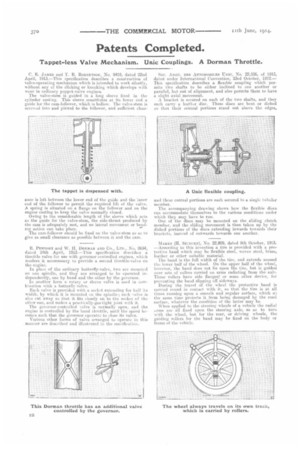Patents Completed.
Page 26

If you've noticed an error in this article please click here to report it so we can fix it.
Tappet-less Valve Mechanism. Unic Couplings. A Dorman Throttle.
C. E. JAMES and T. R. ROBERTSON, No 9419, dated 22nd 1913.—This specification describes a construction of valve-operating mechanism which is intended to work silently, without any of the clicking or knocking which develops with wear in ordinary poppet-valve engines.
The valve-stem is guided in a long sleeve fixed in the cylinder casting. This sleeve constitutes at its lower end a guide for the cam-follower, which is hollow. The valve-stem is screwed into and pinned to the follower, and sufficient clear ance is left between the lower end of the guide and the inner end of the follower to permit the required lift of the valve. A spring is situated on a flange on the follower and on the engine casting to keep the valve normally closed. Owing to the considerable length of the sleeve which acts as the guide for the valve-stem, the side-thrust produced by the cam is adequately met, and no lateral movement or bending action can take place. The cam-follower should be fixed on the valve-stem so as to give as small clearance as possible between it and the cam.
R. PENTONE and W. H. DORMAN AND CO., LTD., No 9694, dated 24th April, 1913.—This specifieatien describes a throttle valve for use with governor-controlled engines, which renders it unnecessary to provide a second throttle-valve on the en,,,ina.
la place of the ordinary butterfly-valve, two are mounted on one spindle, and they aro arranged to be operated independently, one by hand and the other by the governor.
In another form a rotary or sleeve valve is used in combination with a butterfly-valve.
Each valve is provided with a. socket extending for half its width, by which it is mounted en the spindle; each valve is alco cut, away so that it fits closely on to the socket of the other one, and makes a practically-gas-tight joint with it. The governor-controlled valve is normally open, acid the engine is controlled by the hand throttle, until the speed becomes such that the governor operatce to close its valve. Various other forms of valve arranged to operate in this . manner are described and illustrated in the specification. SOC. ANON. DES AIITO2rLORILES 'Hann, No. 22,526, of 1913, dated under International Convention, 23rd October, 1912.— This specification describes a flexible coupling which permits two shafts to he either inclined to one another or parallel, but out of alignment, and also permits them to have a slight axial movement. A bracket is secured on each of the two shafts, and they each carry a leather disc. These discs are bent or dished so that their central portions stand out above the edges, and these central portions are each secured to a single tubular member.
The accompanying drawing shows how the flexible discs can accommodate themselves to the various conditions under which they may have to run. One of the discs may be mounted on the sliding clutch member, and the sliding movement is then taken up by the dished portions of the discs extending inwards towards their brackets, instead of outwards towards one another.
Musks (H. Simufics), No. 22,809, dated 9th October, 1913. —According to this invention a tire is provided with a protective band which may be flexible steel, woven steel, brass, leather or other suitable material.
The band is the full width of the tire, and extends around the lower half of the wheel. On the upper half of the wheel, however, the band does not lie upon the tire, but is guided over sets of rollers carried OR arms radiating from the axle. These rollers have side flanges; or some other device, for preventing the band slipping off sideways.
During the travel of the wheel the protective band is carried round in contact with it, so that the tire is at all titnea running upon a smooth and regular surface, which as the same time protects it from being damaged by the road surface, whatever the condition of the latter may be.
When applied to the steering wheels of a vehicle the radial arms are all fixed upon the steering axle, so as to turn lvith the wheel, but for the roar, or driving wheels, the guiding rollers for the band may be fixed on the body or frame of the vehicle.

























